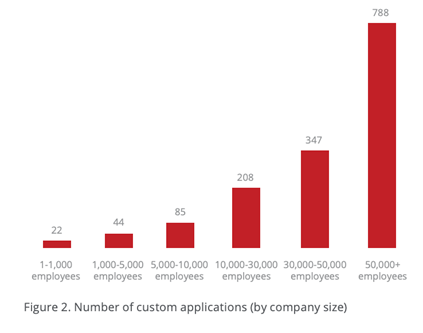Why SD-WAN? The Real Question Is Why Not?

Surf an ocean of endless information without having to turn a page in an encyclopedia — that’s how folks in the 90s were introduced to the internet. 2.5Mb of web space and a 33.6Kbps modem is what the dial-up internet offered its users for connecting to the world wide web amid a ballad of hiss and beeps.
Eventually, as the online world drifted away from being bland pages of texts to flash videos and online music, users needed more robust network hardware than the dial-modem to feed their curiosity around this new-found utopia.
And Boom! Broadband internet happened in the 2000s. A robust and much faster successor to the dial-up model; one which did not need a callout over the phone line to establish a connection.
Today, the internet permeates every facet of modern life and presents a dizzyingly wide range of possibilities for businesses and enterprises, diluting the conventional constraint of communication and collaboration.
Why The History Lesson?
The sum total of global internet traffic in 1984 stood at 15 Gigabytes per month. Fast forward to 2020, and the average internet traffic per user is 15 Gigabytes/month. The point that I’m trying to make is that our reliance on the internet was different in the 90s, and it’s different now. Online traffic and internet usage have mutated — both in quantity and variety.

For better or worse, enterprises are expanding their global footprint by the day. They need better communication with their branch offices and to be seamlessly plugged into their cloud resources and SaaS applications. With rising needs for faster WANs to access centralized computing sources, enterprises cannot be competing for bandwidth with the regular folks living in the utopia of streaming devices and smartphones.
That leaves us with two options. Either spend a fortune on private networks or implement WAN Optimization and add more intelligence to the existing ones. This is where a Software-Defined WAN steps in.
Why SD-WAN?
There is an obvious reason why you prefer flying overseas vs. taking buses or railroads. SD-WAN technology finds its footing in software-defined networking. It builds upon software and virtualization technologies to create a WAN network, making it a cut above the rest. Here are the top five features that should give you an idea of what an intelligent network delivers:
1. Application Aware
From the first dialled call to a prospect for the first meeting, to the time services are deployed, or the product is sold, enterprises rely on a magnitude of applications. According to McAfee’s report, on average, companies with fewer than 1,000 employees run an average of 22 custom applications. The largest enterprises with more than 50,000 employees run 788 on average.

With so many critical applications to run, a network cannot afford to be application agnostic. SD-WAN solutions can discern between cloud, virtual and premise-based applications, optimizing their performance, as well as that of the systems and elements they are linked to. An application aware network also dynamically responds to other traffic based parameters such as devices, traffic flows and user locations, mapping them to an appropriate class of service.
2. Centralized Control
Centralized control is a boon for globally dispersed enterprises and ones in the midst of an expansion plan. Traditionally, IT engineers were forced to plan road trips to every branch site that needed provisioning or scheduled maintenance activities.
With centralized control, global sites and branch office configurations can be pushed out from a single location within a few clicks. Just deploy an SD-WAN device at the concerned site, and it can then download its crypto certificate, policies, configurations to automatically start studying the traffic patterns. Furthermore, by creating templates around routing and security policies, a network admin can push changes to multiple sites with a single click.
3. Automation
Why are Tesla’s all the rage? Who doesn’t like being driven around by a chauffeur? The SD-WAN and automation combo let network admins configure policies and draft dynamic responses to varying traffic patterns.
The automation practices range from automatic ticket resolutions, switching networks based on application requirements and quality of WAN connections, handling failover scenarios, sending alerts, provisioning policies, SLA monitoring, bandwidth allocation, configuration settings, and what have you. Automation to networking is what Jarvis is to Iron Man.
4. Security
To support the growing number of remote users, VPN connections, and various devices accessing the resources, the network and security elements need to be in perfect sync. SD-WAN comes with a handful of security features compared to a pure internet-based network.
These features help users implement a fine-grained segmentation approach and apply granular security controls pertaining to a certain resource group. For example, a specific set of policies for on-premises resources and a distinct one for cloud-based applications such as Office 365. Furthermore, these security features can be extended from the WAN edge across the entire backbone. Users can opt for an integrated security solution or go with the best-of-breed, third-party security solutions. Read more here.
5. Visibility and Detailed Reporting
Understanding the elements that contribute to the complexity and availability of a network is a critical factor in maintaining its integrity, and in turn that of the business. This is where visibility comes in.
Unlike the dumb pipes, SD-WAN delivers dashboards that enable the network admins to map network usage, application behaviour, consumption tracking, network anomalies, active sites, traffic patterns, and pretty much every detail they need for network management. The intelligence helps them configure the network and aptly deploy resources to reap the best performance out of every application. Everything that you need to learn about network visibility can be found in the whitepaper, here.
Press That Button
To keep up with trends such as cloud and mobile computing, your network needs to be intelligent. Most elements in today’s enterprise landscape are dynamic — be it application, device, users or location. An intelligent network should be able to work in tandem with these moving pieces and churn out the best possible network experience.
SD-WAN can mark the line of demarcation between businesses who score on opportunities and the ones who can’t.
Confused where to start? Allow us to help.






